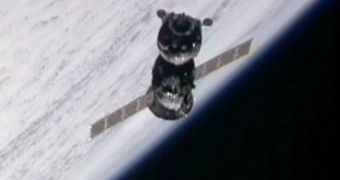American astronaut Scott Kelly and Russian cosmonauts Alexander Kaleri and Oleg Skripochka arrived safely at the International Space Station this Saturday, October 9, aboard a Soyuz capsule.
The spacecraft, designated 01M, is the first of a new reiteration of the tried-and-true Soviet-era icon. The capsule features a new cooling system for its electronics, alongside new guidance, navigation, control and data processing systems.
Docking took place at 8:01 pm EDT (0001 GMT Sunday), when the three astronauts completed a two-day journey traveling in low-Earth orbit (LEO), catching up with the ISS.
All three spaceflyers onboard the Soyuz will remain on the orbital facility for up to six months, as part of the Expedition 25/26 crew. As they arrived at the ISS on Saturday, they completed the six-member crew aboard the ISS.
Soyuz TMA-01M launched from the Baikonur Cosmodrome in Kazakhstan on October 7, at 2310 GMT. The mission took off from the same launch pad that sent the first artificial satellite in space.
The Sputnik was launched on October 4, 1957, in what would be a glove thrown for the United States. That historic launch is what made the US put a man on the Moon in response.
Docking for the modern Soyuz capsule took place as the two spacecrafts were flying some 220 miles (354 kilometers) above the southern Pacific Ocean off the Chilean coast.
Already aboard the ISS are NASA astronauts and Expedition 25 Commander Doug Wheelock, and flight engineers Shannon Walker (NASA) and Fyodor Yurchikhin (RosCosmos).
The three are scheduled to return home in November, when Expedition 26 begins. At that time, Wheelock will hand over command to Scott Kelly.
“The main goal is to keep the station in good shape and to maintain all the equipment working, and to perform a huge scientific program for all the international partners,” Kaleri explained before the launch.
“For me personally, my main task will be to test the upgraded Soyuz in flight. So for me, the most important and most valuable flight stages will be from the launch to the docking, from undocking to landing,” he added, quoted by Space.
Aleksandr Yuriyevich Kaleri was the veteran cosmonaut on the Soyuz, having already participated in several long-term stays in space, aboard both the ISS and the Russian-built space station Mir.
He has spent nearly 610 combined days in space, and has a total of 25 hours and 45 minutes of extra-vehicular activities (EVA) under his belt. He will be part of the Expedition 25/26 crew.
Scott Joseph Kelly is at his third spaceflight to the International Space Station. He has already spent nearly 21 combined days into space. Skripochka is at his first flight into space.
For the three spaceflyers that just arrived at the ISS, the next five to six months will be a very busy time, which will see two shuttle flights arriving on the orbital lab.
Discovery will launch to the ISS in November, while Endeavor will dock in February. The European-built Automated Transfer Vehicle (ATV) Johannes Kepler is also scheduled to arrive in February.

 14 DAY TRIAL //
14 DAY TRIAL //